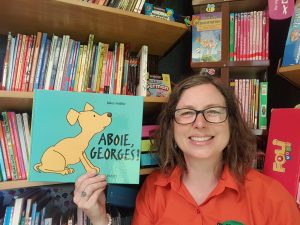
I have known about this book for many years, yet I only bought it very recently… because it is a translation from a text in English, and I always thrive to discover authentic stories… However it really is too good not to use with children! I and they love it!
Click here to watch a short video of me introducing this story to you.
Language of text: French
Type of text: picture book
Author or source: Jules Feiffer at Pastel, l’école des loisirs
Intended age of students: Key Stage 1/2/3
Source reference: 9782211057189
This is the story of the day Georges the dog’s mum wants him to practise barking, but he cannot… instead he makes other animals’ noises! Why could that be?!
From the very first reading, even with very small children, you can get them to join in with the phrase “Aboie, George!” every time you do a certain agree action. They can also easily join in with “wouf”. On second reading, they can join in with the animal noises of which there are only 4 and they easily remembered as they are repeated throughout the story.
You can use it to teach or recap some animal names; you can pause your telling of the story and let the children say the names of the animals in French as well as the noises they make. They will truly feel part of the story.
Rationale:
This book is a lot of fun to share with children, especially with the twist at the end. It enables us to introduce French onomatopoeia, which can be different from English ones, especially for animal noises.
There is a lot of repetition in this story, including repetition of verbs like “dit” and “fait”, so if you point this out to the children and add gesture to those verbs, they will easily remember them. You can also focus on less common verbs like “plonge” and “retire” with older children – and link them to the words “plunge” and “retire” in English.
Outcomes:
With younger children, on every page you could ask them in French how they think the mum is feeling, and they could answer with simple phrases that they know. With older children, you could introduce more interesting adjectives like “patiente, impatiente, énervée, agacée, anéantie, heureuse”.
The children could rewrite their own version of the story with different animals that they know or want to know and their noises, preferably in French.
Topics or themes:
animals; phonics from onomatopoeia. eg “woof” is “wouf” is French
Grammar:
masculine and feminine adjectives when describing the mum
How much time required:
1-2 lessons
I have found some interesting resources to help exploit this story further: click here and here to view them.
Click here to buy the book here at Little Linguist.
What is YOUR favourite book about animal noises? Please tell me in the comments below!
N.B. Would you like to read about books, ideas, resources and opportunities for the primary languages classroom? Then click here to receive a monthly round up of my blog (and more!) straight in your mail box!

